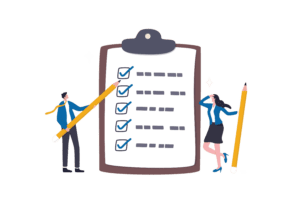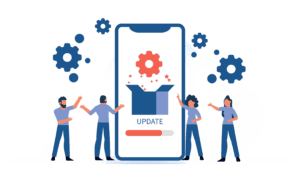
The complete guide to on-page SEO

If you’re looking to improve your organic SEO and rank higher – and do it in a big way – then on-page SEO is the thing you need. In digital marketing and online publishing, very little is left to chance.
With the proliferation of content, a super-competitive landscape, and search engine algorithms that are rolling out all the time, staying on top of your optimisations is the only way to keep you on top.
In this guide, we’ll touch on the definition of on-page optimisation, which aspects you should consider in your SEO strategy, and the latest developments at the time of writing.
But first, let’s get properly acquainted with on-page optimisation.
On-page SEO and its checklist
This is a definition that pretty much does what it says on the tin.
‘On-page’ refers to all the optimisations that are made to a particular page on a website, in a bid to get it ranking higher for queries related to a chosen keyword. But some changes, like headings and images, might be visible with more technical fixes happening in the ‘backend’ of the CMS.
Usually conducted as part of a wider SEO strategy, and in conjunction with Off-page SEO, whatever you choose to carry out should bring in relevant traffic to your pages. So if you optimise a good chunk of your website, then the stronger your website’s offering is – attracting search engines and users alike.
That, ultimately, is the goal of good search engine optimisation.

On-page SEO isn’t a one-size-fits-all approach. Depending on your website, the industry you operate in and the audience you’re hoping to reach, you might pick and choose various aspects for your strategies.
In this next section, we’ll touch on some of the key factors in on-page SEO.
Keyword research
Arguably the backbone of content production, keyword research is the guiding process of identifying relevant search terms that your target audience uses to search. This section of your strategy can help you customise content to user search intent and boost your chances of ranking for those keywords.
Content quality
This is the general ‘usefulness’ of your website’s content. Always aim to create high-quality content that is informative, trustworthy, and addresses the specific needs of your target audience – without boring them to death.
Content writer, Cara Dudgeon, gives her expert advice on creating quality content and how Embryo approaches this process:

“Creating high quality content for your brand involves two things – understanding your audience, products, and services and ensuring fantastic writers are at the helm.
As Google’s algorithm becomes more sophisticated it is recognising high quality content more than ever. This means that the quality of your content is just as important as the optimisation of it.
Our team works to understand your brand and your priorities as a business and then conducts in depth research to ensure the high-quality, captivating content we write can be found for the terms that drive leads and revenue. Whether it’s adhering to a well established tone of voice or helping your brand sound the way you want our team can do it all.”
Keyword placement
Once you’ve got your keywords, where do you put them? Search engines look for target keywords throughout your web pages, often scanning titles, headings, body content, and image alt text to judge how relevant your text is. Whatever you do, prioritise natural placement over keyword stuffing – or you could face penalisation.
Images
Top-quality imagery that contextualises and adds interest to your content is a must. Images can also be optimised for on-page SEO, to improve loading times and include descriptive alt text for accessibility and keyword reach.
Title
The title is the headline that pops up in your SERPS and sits at the top of your content. It should accurately reflect your content and include your target keyword while coming under 60 characters.
Headings
These structured sections work by breaking up your content into sections and organising it by topic and importance. As a rule, headings should be clear, and concise, and incorporate relevant keywords where possible.
Meta description
This is the summary of your content that pops up under the title tag on the SERPS. Coming in at around 155 characters, it should give users enough information to make them want to click through, as well as giving them an accurate idea of what your page is about.
URL
This is the ‘postcode’ for your webpage. You can optimise your URL slugs to be as descriptive as possible – where possible – while including your target keyword.
Links
Links are crucial connections between web pages, both internally on your website and from the wider internet, through other high-authority websites with backlinks. These can also impact your rankings favourably, as they work as a ‘thumbs up’ guarantee that your pages are useful and accurate.
Technical
Technical SEO is all about what’s happening to your website internally. These changes can impact – and improve – user experience and search engine crawling, such as website speed, mobile-friendliness, and overall code structure.
What are the latest developments in on-page web optimisation?

As we look to the future of on-page SEO, we all know that AI is likely to play a greater role in content and search query generation. But there is also a fresh focus on user experience and E-E-A-T factors.
Let’s get into it.
Matching search intent
As Google continues to prioritise content that directly addresses the user’s search intent with its new user-focused algorithms, matching your search intent is crucial. That means fully researching and understanding what your audience is looking for through specific keywords and search phrases, before tweaking your content to meet them.
User experience as a ranking factor
On-page SEO should – and does – go beyond keywords. That’s why you should on technically optimising for user experience, improving things such as clear navigation, mobile-friendliness, and fast loading times.
On-page SEO doesn’t stay still
As digital marketers and SEO experts, we need to stay focused and adapt where possible – but don’t be afraid to try out new strategies, and prioritise the needs of your users above all else. In this field, the groundwork for long-term search success is high-quality content, strong user experience, and expertise, which we hope we’ve covered for you in this guide.
If you’d like us to carry out on-page optimisation for your business – our experts can help.
FAQs
Answered by Claire-Marie Wilder
Does on-page SEO have to be done on each page individually?
Yes, every page has to have a specific intent, so all optimisations need to be carried out on each page. Every factor needs to be optimised for that intent.
Do larger pages take longer to optimise for on-page SEO?
Yes, naturally larger pages can take longer because of the pure scale of the content. Look at competitors and see what their content is looking like. Hitting word counts and adding internal links/images to pages is what can take the most time.
Which part of on-page SEO should I start with?
There is no particular order for carrying out on-page optimisations, For new websites, this depends on your content, but it is important to start with the page title and H2 headings. You should also consider if images are going to be an important factor in your content and make sure all best practice is followed for this. This should be followed by internal links, external links, technical SEO etc.
Is on-page SEO the same as on-site SEO?
Yes, they are the same and are often used interchangeably.